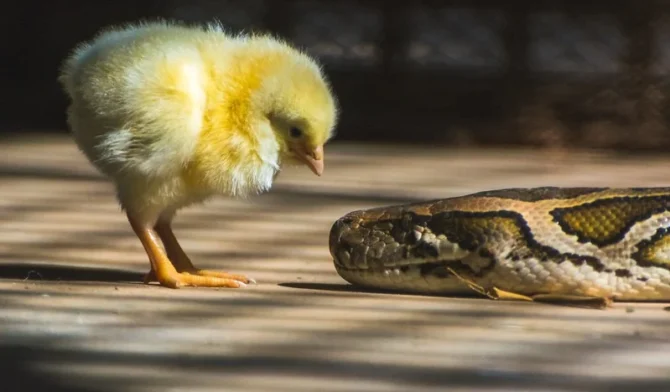
Imagine a serene farm scene: chickens clucking peacefully, scratching the ground in search of their next meal. Suddenly, a slithering snake enters the picture. What happens next? Would the docile chicken confront the intruder or flee?
The age-old question, “Do chickens eat snakes?” has baffled many. While it might sound like the plot of an animated movie, the reality is far more intricate and fascinating. Join us on this journey as we unravel the mysteries of the dynamic between chickens and snakes, shedding light on myths and presenting the facts.
Natural Behavior of Chickens
Chickens, often seen clucking around in backyards or farms, are fascinating creatures with a range of behaviors that have evolved over thousands of years. To truly grasp the dynamics between chickens and snakes, one must first delve into the innate behaviors and characteristics of these birds.
Omnivorous Diet
Chickens are omnivores, which means their diet is diverse, encompassing both plant and animal matter. This varied diet has allowed them to thrive in different environments, from dense forests to open pastures.
- Grains and Seeds: These are staple foods for most chicken breeds. Whether it’s corn, wheat, barley, or sunflower seeds, chickens will peck at these with enthusiasm.
- Fruits and Vegetables: Chickens enjoy a variety of fruits and vegetables, from berries and apples to leafy greens and carrots. These not only provide essential nutrients but also add variety to their diet.
- Insects and Small Animals: Chickens are adept hunters. They’ll chase after and consume insects like beetles, worms, and even small rodents or amphibians if given the opportunity.
Foraging Instincts
One of the most prominent behaviors in chickens is their instinct to forage. This behavior is hardwired into their DNA:
- Scratching the Ground: Using their strong feet, chickens will scratch the ground to uncover hidden treats. This action aerates the soil, helping with soil health, but primarily serves their quest for food.
- Dust Bathing: While this isn’t directly related to foraging for food, it’s a common sight in a chicken’s daily routine. Dust bathing helps them get rid of parasites and keeps their feathers clean.
Opportunistic Eaters
Chickens are known to be opportunistic when it comes to food. If they come across something edible, they are likely to give it a try:
- Varied Diet: Their opportunistic nature means their diet can be quite varied, depending on the environment they are in. In a forested area, they might consume more insects and natural fruits, while in a farm setting, grains might dominate their diet.
- Adaptable Feeders: Chickens can adapt their diet based on availability. In times of scarcity, they might eat more plant matter, while an abundance of insects during a particular season might see them feasting on these critters.
Social Structure and Pecking Order
Beyond their eating habits, chickens have a complex social structure. They establish a ‘pecking order,’ which determines the social standing of each bird in the flock. This hierarchy affects feeding, nesting, and even dust bathing.
The Encounter
The interaction between chickens and snakes is a dance of nature, a blend of curiosity, fear, and survival instincts. When these two creatures cross paths, the outcome can vary widely based on several factors:
Size of the Snake:
- Smaller Snakes: These are often seen as potential meals by chickens. Especially if they are non-venomous, their size makes them vulnerable to a chicken’s pecking and hunting instincts. Chickens, with their sharp eyesight, can quickly spot these smaller reptiles and might decide to investigate.
- Larger Snakes: These can be intimidating to chickens. A sizable snake, especially a venomous one, can pose a significant threat, not just to chicks but even to grown hens and roosters. In such scenarios, chickens might sound alarm calls, alerting the rest of the flock.
Type of Chicken:
- Breed Differences: Just as dogs or cats have varied temperaments based on their breeds, so do chickens. Breeds like the Rhode Island Red or the Plymouth Rock might be more confrontational, while Silkies or Polish chickens might be more reserved.
- Age and Experience: Older chickens, having encountered more threats in their lifetime, might be more cautious or, conversely, more aggressive based on past experiences. Younger chickens might be more curious, sometimes to their detriment.
Environment:
- Within the Coop: A snake’s entry into a chicken coop is akin to a home invasion. Chickens are more likely to confront the intruder in a space they consider their own. The confined space can lead to heightened stress and more aggressive behavior.
- Open Spaces: In a broader, open environment, chickens have the option to flee. Depending on the perceived threat level of the snake, chickens might choose the safer route of avoidance rather than confrontation.
The Hunt and Feast
The act of a chicken hunting a snake is a testament to the bird’s adaptability and survival instincts. Here’s a more in-depth look at this process:
The Approach:
- Curiosity First: Chickens are naturally curious creatures. Upon spotting a small snake, their first instinct might be to approach and inspect. This inspection involves cautious pecking or nudging the snake with their beak.
- Assessing the Threat: If the snake hisses, strikes, or shows any signs of aggression, the chicken will gauge whether it’s worth the risk. This decision is often a split-second one, driven by instinct.
The Attack:
- Immobilizing the Prey: If the chicken decides to go on the offensive, it will aim to immobilize the snake first. This is done by pecking at its head or vital areas. Multiple chickens might join in, especially if they sense the snake is weakened.
- Swallowing: Once the snake is incapacitated, the chicken will proceed to swallow it whole. This act is similar to how they consume larger insects, worms, or even small rodents. The swallowing can take time, with the chicken often pacing around, taking breaks, and adjusting its grip on the snake.
The Aftermath:
- Digestion: Snakes provide a rich source of protein. Once swallowed, the digestion process begins, and the snake is broken down in the chicken’s stomach.
- Behavioral Changes: After such an intense encounter, chickens might become more alert or even agitated. They could be seen scanning their environment more vigilantly for a while.
Benefits
There are several benefits to chickens eating snakes:
- Natural Pest Control: Chickens help in reducing the population of small snakes, which can be pests in certain areas.
- Nutrition: Snakes provide a good source of protein for chickens, contributing to their overall health.
- Safety: By eliminating smaller snakes, chickens can reduce the risk of larger, potentially venomous snakes being attracted to the area.
Risks Involved
While there are benefits, there are also risks associated with chickens eating snakes:
- Venomous Snakes: If a chicken tries to eat a venomous snake and gets bitten, it can be fatal for the chicken.
- Disease Transmission: Snakes can carry diseases or parasites that might be harmful to chickens.
- Choking Hazard: Larger snakes can pose a choking risk if a chicken tries to swallow them.
FAQ
How do chickens react to the presence of a snake’s shed skin in their environment?
Chickens are naturally curious creatures. If they come across a snake’s shed skin, they might inspect it, peck at it, or even play with it. However, they usually won’t consume it as they would with an actual snake.
Do roosters have a different reaction to snakes compared to hens?
Roosters are generally more aggressive and protective than hens. While both hens and roosters might confront a snake, a rooster is more likely to take an aggressive stance, especially if he perceives the snake as a threat to his flock.
Can the presence of chickens deter snakes from entering a particular area?
While chickens can hunt and eat smaller snakes, their presence alone might not be a significant deterrent for larger snakes. However, the regular activity and noise from a flock of chickens can make an area less appealing to snakes seeking a quiet place.
Do mother hens react differently to snakes when they have chicks?
Absolutely. Mother hens are incredibly protective of their chicks. If they perceive a snake as a threat to their young, they are likely to become more aggressive and confrontational than they might be otherwise.
How can I differentiate between a venomous and non-venomous snake in my chicken coop?
It’s essential to familiarize yourself with the local snake species in your area. Characteristics like head shape, eye shape, and color patterns can help identify venomous snakes. However, always exercise caution and avoid handling any snake unless you’re certain of its species and potential danger.
Are chicks more vulnerable to snake attacks than adult chickens?
Yes, chicks are more vulnerable due to their smaller size and lack of defensive capabilities. Some snakes might see chicks as an easy meal. It’s crucial to ensure that the coop and brooding area are secure from potential snake invasions, especially when raising chicks.
Conclusion
The relationship between chickens and snakes is a complex one, filled with intrigue and surprises. While chickens can indeed eat snakes, it’s essential to be aware of the potential risks and benefits. Whether you’re a poultry enthusiast or just curious about nature’s wonders, understanding this dynamic can offer valuable insights into the animal kingdom’s intricacies.


